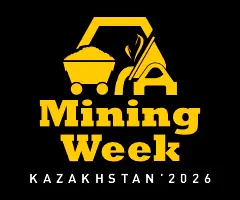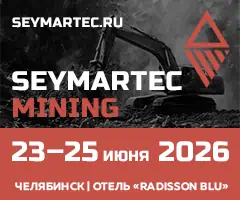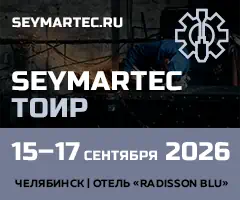Scanning total stations in solving mine surveying tasks in underground mining of the Perevalnoye deposit
 V.V. Arno1 , E.P. Kolesnichenko2, I.Yu Garifulina1, E.A. Mikkelsen1
V.V. Arno1 , E.P. Kolesnichenko2, I.Yu Garifulina1, E.A. Mikkelsen1
1 North-Eastern State University, Magadan, Russian Federation
2 Lomonosov Moscow State University, Moscow, Russian Federation
Russian Mining Industry №3 / 2025 p. 40-44
Abstract: The article presents a comparative study of two laser scanners, i.e. GO SLAM and Void Scanner VS+, for solving mine surveying tasks at the Perevalnoye field in underground mining. The focus is made on analyzing the operation of devices in difficult conditions of the underground environment, such as dust, gas contamination and high humidity, during the laying of rubble concrete. The purpose of the study was to conduct a comparative analysis of the technical characteristics and performance of the scanners in practice. The research methods included analysis of the geological structure of the site, selection of a stope for experiments, studying the technical characteristics of the scanners, a methodology for comparative measurements in dusty and dust-free conditions, analyzing the influence of external factors of the underground environment and assessing the cost and availability of the equipment. The results of the study indicate the advantages and limitations of each scanner in different conditions. GO SLAM showed high resistance to adverse conditions and efficiency in rapid scanning, while Void Scanner VS+ provided high measurement accuracy under favorable conditions, but had limitations in a polluted environment.
Keywords: scanning total station, surveying, GO SLAM, Void Scanner VS+, rubble-concrete bookmark, dustiness
For citation: Arno V.V., Kolesnichenko E.P., Garifulina I.Yu., Mikkelsen E.A. Scanning total stations in solving mine surveying tasks in underground mining of the Perevalnoye deposit. Russian Mining Industry. 2025;(3):40–44. (In Russ.) https://doi.org/10.30686/1609-9192-2025-3-40-44
Article info
Received: 02.03.2025
Revised: 10.04.2025
Accepted: 10.04.2025
Information about the authors
Veronika V. Arno – Cand. Sci. (Eng.), Associate Professor, Polytechnic Institute, North-Eastern State University, Magadan, Russian Federation; e-mail: This email address is being protected from spambots. You need JavaScript enabled to view it.
Eva P. Kolesnichenko – Student of the field of training “State and Municipal Audit”, Higher School of Public Audit, Lomonosov Moscow State University, Moscow, Russian Federation; e-mail: This email address is being protected from spambots. You need JavaScript enabled to view it.
Irina Yu. Garifulina – Senior Lecturer of the Department of Geology and Mining, Polytechnic Institute, North-Eastern State University, Magadan, Russian Federation; e-mail: This email address is being protected from spambots. You need JavaScript enabled to view it.
Ekaterina A. Mikkelsen – Student of the field of study “Mining”, specialization “Underground Mining of Ore Deposits”, Polytechnic Institute, North-Eastern State University, Magadan, Russian Federation; e-mail: This email address is being protected from spambots. You need JavaScript enabled to view it.
Authors’ contribution
V.V. Arno – research idea, statement of the conflict between the current paradigm and the new facts, writing the scientific paper.
E.P. Kolesnichenko, E.A. Mikkelsen – results evaluation and correction of the written paper.
I.Yu. Garifulina – evaluation of the research results, selection and collection of materials for research.
Conflict of interest
The authors declare no conflict of interest.
References
1. Кузьмин Т.В., Васильев М.Д., Голубко Б.П. Наземное и мобильное лазерное сканирование в маркшейдерской съёмке при разработке месторождений открытым способом. В кн.: Уральская горная школа-регионам: материалы междунар. науч.-практ. конф., г. Екатеринбург, 6–7 апреля 2020 г. Екатеринбург: Уральский государственный горный университет; 2020. С. 241–242.
2. Алтынцев М.А. Применение технологии наземного лазерного сканирования для создания обмерных чертежей фасадов зданий. Вестник СГУГиТ (Сибирского государственного университета геосистем и технологий). 2022;27(3):5–18. https://doi.org/10.33764/2411-1759-2022-27-3-5-18 Altyntsev M.A. Application of terrestrial laser scanning technology for creating record drawings of building facades. Vestnik of the Siberian State University of Geosystems and Technologies (SSUGT). 2022;27(3):5–18. (In Russ.) https://doi.org/10.33764/2411-1759-2022-27-3-5-18
3. Бесимбаева О.Г., Хмырова Е.Н., Олейникова Е.А. Маркшейдерское обеспечение проведения горных работ с применением инновационных технологий. Восточно-европейский научный журнал. 2016;14(3):60–65. Besimbaeva O.G., Khmyrova E.N., Oleynikova E.A. Surveying the provision of mining with the use of innovative technologies. East European Scientific Journal. 2016;14(3):60–65. (In Russ.)
4. Алтынцев М.А., Карпик П.А. Методика создания цифровых трехмерных моделей объектов инфраструктуры нефтегазодобывающих комплексов с применением наземного лазерного сканирования. Вестник СГУГиТ (Сибирского государственного университета геосистем и технологий). 2020;25(2):121–139. https://doi.org/10.33764/2411-1759-2020-25-2-121-139 Altyntsev M.A., Karpik P.A. The technique for creating digital three-dimensional models of oil and gas manufacturing facility object infrastructure using terrestrial laser scanning. Vestnik of the Siberian State University of Geosystems and Technologies (SSUGT). 2020;25(2):121–139. (In Russ.) https://doi.org/10.33764/2411-1759-2020-25-2-121-139
5. Грищенкова Е.Н., Мустафин М.Г. Пространственная визуализация процесса сдвижения с помощью инструментальных средств 3DS MAX. Горный информационно-аналитический бюллетень. 2017;(9):36–41. Режим доступа: https://giab-online.ru/files/Data/2017/9/36_41_9_2017.pdf (дата обращения: 27.02.2025). Grishchenkova E.N., Mustafin M.G. Spatial visualization of displacement using 3DSMAX apparatus. Mining Informational and Analytical Bulletin. 2017;(9):36–41. (In Russ.) Available at: https://giab-online.ru/files/Data/2017/9/36_41_9_2017.pdf (accessed: 27.02.2025).
6. Курбатова В.В. Аппроксимация методики наземной лазерно-сканирующей тахеометрии к съемке подземных выработок. Вектор ГеоНаук. 2018;1(3):40–52. Kurbatova V.V. Approximation methods terrestrial laser scanning of tacheometry the survey of underground workings. Vector of Geosciences. 2018;1(3):40–52. (In Russ.)
7. Курбатова В.В. Валидность сканирующей тахеометрии в решении комплекса маркшейдерских задач. Вектор ГеоНаук. 2018;1(1):8–23. Kurbatova V.V. The validity of the scan tacheometry in the solution of complex surveying tasks. Vector of Geosciences. 2018;1(1):8–23. (In Russ.)
8. Brown A., Williams C. Advances in scanner technology for geological surveys in mining operations. Journal of Geospatial Engineering. 2020;15(1):32–45.
9. Овчаренко А.В., Удоратин В.В. Оперативное изучение подземных пустот с помощью лазерного 3D-сканирования. Вестник института геологии Коми научного центра Уральского отделения РАН. 2015;(4):20–25. Ovcharenko A.V., Udoratin V.V. The operative study of underground cavities by 3D-scanning. Vestnik of Institute of Geology of Komi Science Center of Ural branch RAS. 2015;(4):20–25. (In Russ.)
10. Палатурян Р.А. Преимущества сканирующего тахеометра на практике. Наука. Техника. Технологии (политехнический вестник). 2017;(2):230–233. Palaturyan R.A. Advantages of the scanning total station in practice. Science. Engineering. Technology (polytechnical bulletin). 2017;(2):230–233. (In Russ.)
11. Oludare I.M., Pradhan B. A decade of modern cave surveying with terrestrial laser scanning: A review of sensors, method and application development. International Journal of Speleology. 2016;45(1):71–88. https://doi.org/10.5038/1827-806X.45.1.1923
12. Wagner A. A new approach for geo-monitoring using modern total stations and RGB + D images. Measurement. 2016;82:64– 74. https://doi.org/10.1016/j.measurement.2015.12.025




